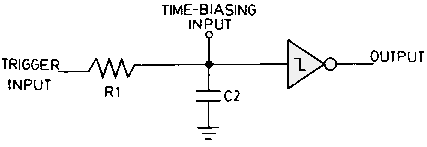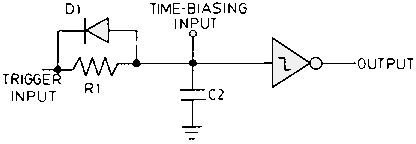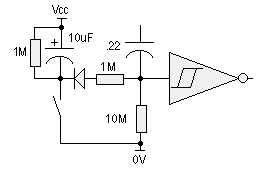|
|
BEAM From the Ground Up is a BEAM Reference Library site.
Nu neurons
Bruce Robinson and Wilf Rigter
explain...
The basic Nv neuron responds to a rising input by switching its normally high output to a low one for a varying amount of time. Given an input that goes from high to low to high again, on the low-to-high transition, the output will go from high to low. After a delay (determined by the resistor and capacitor values), the output will switch back to high. This allows you to chain Nv neurons together and have a signal travel slowly along the chain.
The basic Nu neuron responds to a prolonged change in input. If a high signal is applied to the input, after a delay, the output will switch from high to low and will remain low as long as the input stays high.
One essential difference is that the Nv responds immediately to an input, and sends the output for a time duration -- the delay occurs AFTER the output is sent. The Nu responds to an input after a delay and sends the output continuously -- the delay occurs BEFORE the output is sent.
 |
 |
|
|
|
[As far as schematics are concerned,] the big difference between the two is that the capacitor and resistor are swapped. Each one also has a variation where the resistor (Nv) or capacitor (Nu) is connected to Vcc instead of ground.
Variants
Although the basic diagram shows one input through one
resistor
(the simplest form), the Nu
neuron
is potentially a very complex device. You can create an
Nu
with multiple inputs by giving each input its own resistor,
often with different values. You can also put a diode
in series with each resistor
to determine under what conditions the input will have an
effect (to create separate "on" delays and "off" delays, so
the cap
will charge much more rapidly then it discharges, or vice
versa). And you can have inhibitory
inputs that tend to cancel the effects of the other inputs.
Thus, whether an Nu
fires or not depends on the combined effects of its inputs.
In fact, you will sometimes have a tough time actually
identifying a complex Nu
neuron
in a circuit.
Another major "flavor" of the Nu neuron involves connecting the capacitor to Vcc instead of ground. In this case, input and output conditions are the reverse of what is described above (i.e., "off" is low, a low input causes the neuron to fire).
Tilden's patent itself identifies three variants of the Nu:



Whenever I've slaved an Nv neuron to an Nu neuron, I've used a resistor between the Nu output and the Nv bias point (where the cap, resistor, and inverter input all join). You can do this several ways ...
- The connecting resistor is much larger (at least 4
times the size) than the regular Nv
resistor. This will influence the Nv
timing a little, increasing or decreasing the delay
depending on the Nu
output.
- The connecting resistor is approximately the same
size as the regular Nv
resistor. This will make the Nu
the predominant factor in the Nv
timing.
- Use only the connecting resistor and eliminate the
regular Nv
resistor. This means the Nu
will switch the Nv
between a grounded neuron and a positively connected
neuron.
- Use a diode between the connecting resistor and the
bias point. Depending on the output level of the
Nu
and the direction of the diode, this will either speed up
or slow down the Nv
delay.
- Use a diode between the Nu
and the Nv
bias point. The Nu
will then either kill a process on the Nv,
or inject a new one. This is the original Tilden startup
circuit.
- The Nu
bias point can be used as a ramping analog source to
influence an Nv.
A typical example using a diode is shown below. Note that
the R of the Nu
must be much smaller than the R of the Nv.
The same methods of coupling as described in 1. to 5. can
be used.

- In suspended bicores, the Nvs are not referenced to ground or Vcc however an Nu (including 6.) can be connected to the middle of the suspended resistor or directly influence one or both bias points.
The key to understanding the way the suspended bicore is influenced by an external voltage / current source is to recognize that the null (minimum influence) voltage for a suspended bicore is Vcc / 2. This means if Vcc / 2 is connected to the midpoint of the resistor in a HC suspended bicore with equal capacitors, there is zero effect.
|
|
|
|
|
|
||
|
|
This page was last updated on |
|
